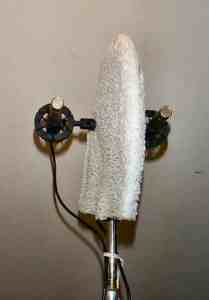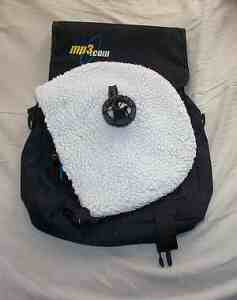|
The Big List has the Latest Scores and Downloads |
Cheap Under $15 Jecklin Disk
Materials
- One square foot of Plexiglas or Acrylite ($2)
- One microphone stand attachment with nut & bolt ($1)
- One 1/2-inch male threaded microphone rod ($1).
- One fleece pony saddlepad ($10 or so on eBay)
- Two microphone mounts (as shipped with microphones).
The idea was to make an inexpensive but very effective Jecklin Disk for recording. This disk creates an ideal acoustic separation without the color introduced by other methods of stereo recording with natural placement. I have used this disk with the excellent Studio Projects C4 microphones.
- Trace a 12-inch (300mm) circle on the Plexiglas and cut the circle carefully with a jigsaw.
- Drill a small hole that fits the microphone stand attachment at 6 o'clock. Drill carefully; these plastics work like wood, but crack more easily.
- Drill a larger hole that fits the male threaded rod approximately 1.5 inches (40mm) in diameter at 9 o'clock.
- Insert the male threaded rod through the hole, and tighten one microphone mount to each side, lining them up. (You may need to add knurled nuts used to tighten microphone clamps.)
- Slip the microphone stand attachment over the small hole in the Plexiglas and tighten the nut & bolt to hold it in place (see photo below).
- Cut one side of the fleece pony saddlepad so it forms a glove. Remove any stitching holding the center together.
- Pull the glove over the Plexiglas disk, and make slits so the microphone mounts just slide through.
- Attach the disk to a microphone stand and install the microphone clamps and shock mounts. The disk is strong, but be careful not to stress the point where it fits to the stand.
- Insert the microphones with omni capsules, and place them 6.5 inches (165mm) apart, with the angle adjusted to capture greatest high-frequency information (on-axis).
- Loop the cords and attach them to the stand so they do not create pressure on the disk.
For sample recordings, listen to the Montpelier Chamber Orchestra on the main Malted/Media site.
For more information on the use and theory of the Jecklin Disk, see Josephson Microphones Tech Note #5.
Page maintained by Dennis Bathory-Kitsz, Contact Form.





